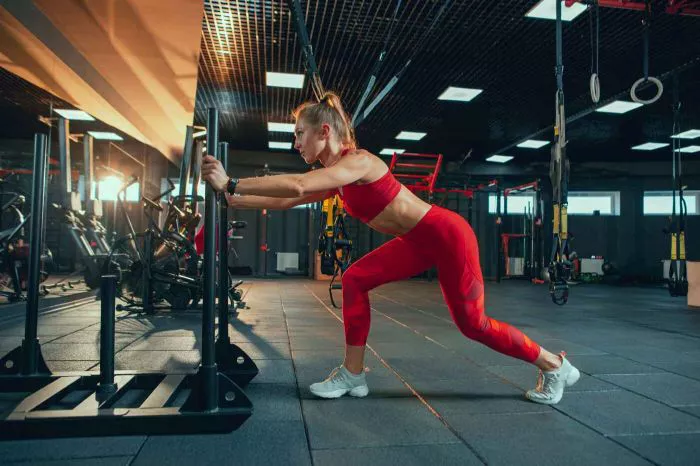The box press exercise, also known as the floor press or bench press variation, is a highly effective strength training exercise that targets the chest, shoulders, and triceps. Similar to the traditional bench press, the box press offers unique advantages and benefits, making it a valuable addition to any strength training routine. In this comprehensive guide, we’ll delve into the details of the box press exercise, including its benefits, technique, variations, and tips for maximizing your results.
Understanding the Box Press Exercise:
The box press exercise is performed by lying on the floor or a sturdy bench with your back flat and feet planted firmly on the ground. Instead of lowering the weight all the way down to the chest, as in a traditional bench press, the box press involves lowering the weight until your upper arms make contact with a box or bench positioned at chest level. This limited range of motion allows you to safely and effectively target the chest muscles while reducing strain on the shoulders and minimizing the risk of injury.
Benefits of the Box Press Exercise:
Increased Range of Motion Control: By limiting the range of motion of the bench press, the box press allows you to focus on controlling the weight throughout the movement, promoting better form and technique. This can help improve muscle activation and reduce the risk of injury, particularly for individuals with shoulder issues or mobility limitations.
Enhanced Chest Muscle Activation: The box press targets the chest muscles, or pectoralis major, more effectively than the traditional bench press, as it eliminates the use of momentum and emphasizes the contraction of the chest muscles throughout the movement. This can lead to greater muscle hypertrophy and strength gains in the chest region over time.
Shoulder-Friendly Variation: For individuals with shoulder pain or discomfort during traditional bench press movements, the box press offers a shoulder-friendly alternative that reduces stress on the shoulder joints. By limiting the range of motion and providing a stable surface for the upper arms to rest on, the box press allows you to perform the exercise with reduced risk of aggravating shoulder issues.
Increased Triceps Activation: In addition to targeting the chest muscles, the box press also engages the triceps to a significant degree, as they are responsible for extending the arms and pushing the weight back up to the starting position. This dual muscle activation makes the box press a highly effective compound exercise for developing both chest and triceps strength and size.
Technique for Performing the Box Press:
To perform the box press exercise correctly and safely, follow these steps:
Set up a sturdy bench or box at chest level and lie flat on your back with your feet planted firmly on the ground.
Grip the barbell with hands slightly wider than shoulder-width apart, palms facing away from you, and unrack the weight.
Lower the weight towards your chest in a controlled manner, keeping your elbows tucked close to your body and your upper arms in contact with the box.
Pause briefly when your upper arms make contact with the box, then press the weight back up to the starting position by extending your arms fully.
Repeat for the desired number of repetitions, maintaining proper form and control throughout the movement.
Variations of the Box Press Exercise:
Dumbbell Box Press: Instead of using a barbell, perform the box press with dumbbells to allow for greater range of motion and unilateral muscle activation. This variation can help improve balance and stability and address muscle imbalances between the left and right sides of the body.
Incline Box Press: Set the bench or box at a slight incline (around 15-30 degrees) to target the upper chest muscles more effectively. This variation can help create a more well-rounded chest development and add variety to your workout routine.
Decline Box Press: Set the bench or box at a decline angle (around 15-30 degrees) to target the lower chest muscles more effectively. This variation can help build strength and definition in the lower chest region and provide a unique challenge to your chest workouts.
Tips for Maximizing Your Box Press Results:
Focus on Form and Control: Prioritize proper form and technique throughout the box press exercise, maintaining a stable core, and controlling the weight throughout the entire range of motion.
Start with Lighter Weights: Begin with lighter weights when first learning the box press technique to ensure proper form and avoid injury. Gradually increase the weight as you become more comfortable with the exercise.
Incorporate Progressive Overload: To continue making progress and building strength with the box press, gradually increase the weight, volume, or intensity of your workouts over time. This progressive overload principle will stimulate muscle growth and adaptation, leading to continued gains in strength and size.
Listen to Your Body: Pay attention to how your body responds to the box press exercise and adjust accordingly. If you experience any pain or discomfort, stop the exercise immediately and consult with a qualified fitness professional or healthcare provider.
Include the Box Press in Your Routine: Incorporate the box press exercise into your chest workouts regularly to reap its full benefits and enhance your chest development. Experiment with different variations and rep ranges to keep your workouts challenging and effective.
The Bottom Line
In conclusion, the box press exercise is a highly effective strength training exercise that targets the chest, shoulders, and triceps while minimizing strain on the shoulders and reducing the risk of injury. By mastering the proper technique, incorporating variations, and following these tips, you can maximize your results and achieve a strong and well-defined chest. Whether you’re a beginner or experienced lifter, the box press is a valuable addition to any strength training routine, helping you build muscle, increase strength, and improve overall fitness levels.
Related Topics:


